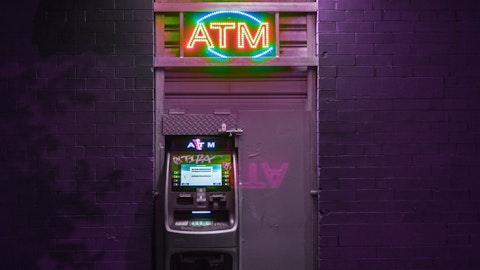Ajai Bambawale: Yes. Thanks, Nigel. I won’t give you a specific number for Q4. But yes, continued normalization is expected. I do think impaireds will continue to rise from current levels. So if you look at our impaired rate, it’s 30; pre-pandemic, it was 38. So we expect that will continue to rise. Performing, again, could be bumpy, depending on the drivers of performing. So, that number could move. But I think for the overall, yes, I am messaging that we’ll be closer to the 35 number. You can work back from that and get an estimate of what Q4 looks like.
Operator: The next question is from Joo Ho Kim with Credit Suisse. Please go ahead.
Joo Ho Kim: Hi. Good afternoon. Thanks for taking it to the overtime here. And just on the 5% buyback with the intention to announce — or the intention to launch 90 million. How quick should we expect the Bank to act on that? And I understand that it will be impacted by market conditions and the overall outlook. But at the time when the 30 million prior NCIB was announced, you had mentioned the expectation to complete that by the end of the summer. So is that a similar pace, call it, 30 million per quarter, something that we can expect with the new buyback?
Bharat Masrani: Again, like you answered the question. It depends on market conditions. This requires regulatory approval. Obviously, it has to go through an approval process, which sometimes is quick, sometimes not so quick. So, one cannot predict exactly. And with respect to the pace, market conditions have a huge impact on that. As you know, as a bank, we come up with an algorithm as to how this should work. It would depend on the number of shares traded in a day. There are certain rules we have to follow that the exchanges put out. So, it’s very difficult to predict, whereas 30 million shares was a much smaller program. And hence, we were in a better position to give you a prediction. But very hard to do when it is of this quantum. And markets are really choppy. They’re very volatile. So, it’s hard to give you a specific time line.
Joo Ho Kim: Got it. I understand. Just on the U.S. business, the noninterest income line here, it seemed to have sort of bottomed out here. So I guess there are — are there more sort of headwinds potentially that you see on that line, whether it’s from a regulatory perspective on card fees or other sort of competitive dynamics that you see that could potentially impact that line? And I guess, overall, if you could offer some thoughts on how you see noninterest income from the U.S. evolving over the near term. Thank you.
Leo Salom: Yes. Thank you for the question. We did have a good quarter from a noninterest income perspective, so growth of 17% on a quarter-on-quarter basis. When you break it down, what I’m encouraged about is we’ve now essentially burnt off the overdraft hangover on a quarter-on-quarter basis, and we’re seeing good fundamental core account fee revenue growth. And that’s both in our core checking account offering, our credit card business and this quarter in wealth as well with the growth that we saw in overall AUA levels. So, I feel good that at least the overdraft piece, which was obviously a sizable impact that we’ve absorbed over the past year, that’s behind us. As we look forward, hard to predict. I think, our core franchise is — focusing on our core franchise growth is probably the most important driver with regards to noninterest income going forward.
I think the one area that we’re certainly watching is the outstanding CFPB late fee guidance that has been put out. I don’t want to speculate now with regards to whether — where that is in the process. But that is one that we’re factoring in, at least in our thought process with regards to what that might — how that might impact 2024. But I come back to — I’m really encouraged about some of the underlying fundamentals that we saw this quarter.
Operator: The next question is from Mike Rizvanovic with KBW Research. Please go ahead.
Mike Rizvanovic: Just had a quick question for Michael on the Canadian mortgage book. So, the 35-plus year amortization, it looks like it came down a little bit sequentially. And I’m not sure if that’s purposeful paydowns or intentional paydowns — proactive paydowns, call it by your borrowers with the negative AM. I’m sure you’re nudging them in that direction. Or is it just a function of you’re just writing a lot of business and it’s all fixed rate?
Michael Rhodes: Yes, a fair question. I know the table you’re referring to when we have seen a decline, certainly or last quarter and from year-end. What we’re seeing is our customers when they’re hitting trigger rate, we have a proactive program to reach out to customers and give them the options, which include lump sum payments, increase their payments, switching to a fixed-rate product, et cetera. And we’re having good uptake. And so I think that table shows consumers reacting to our outreaches with respect to the customers who have trigger rate.
Kelvin Tran: No, I think it’s bang on.
Mike Rizvanovic: And what would that take-up rate be if you can give me an approximation? Like is it like a third of your borrowers with the negative AM? Is it less than that, more? Just trying to get some color on I guess the propensity for borrowers to actually do that voluntarily.
Michael Rhodes: Yes. I don’t — to be fair, I’d probably rather not give you a specific number, but I will say it’s a meaningful number of customers who we reach out to who are making — making the changes.
Operator: There are no further questions registered at this time. I will turn the meeting over to Mr. Bharat Masrani.
Bharat Masrani: Thank you. Thank you, operator. And thank you, all the folks who joined us for this call. Just to end here, another very good quarter from TD. And as usual, I’d like to take this opportunity to thank my colleagues around the world. They do a fantastic job in delivering for all our stakeholders, including our shareholders. And look forward to the call again in approximately 90 days. Thanks very much, folks.
Operator: Thank you. The conference has now ended. Please disconnect your lines at this time, and we thank you for your participation.
Follow Toronto Dominion Bank Ont (NYSE:TD)
Follow Toronto Dominion Bank Ont (NYSE:TD)
Receive real-time insider trading and news alerts




